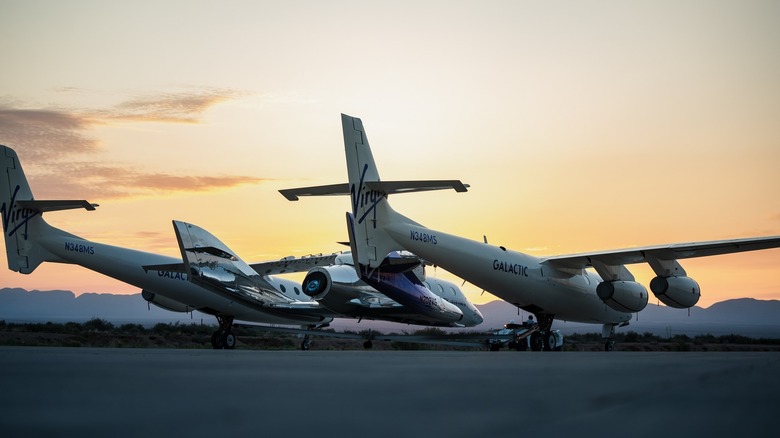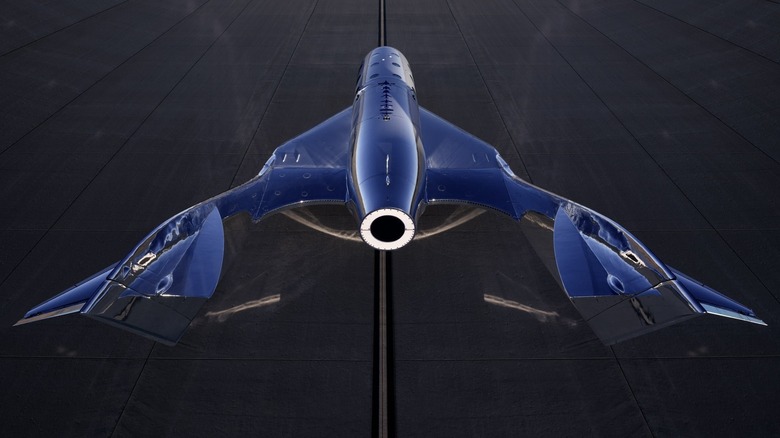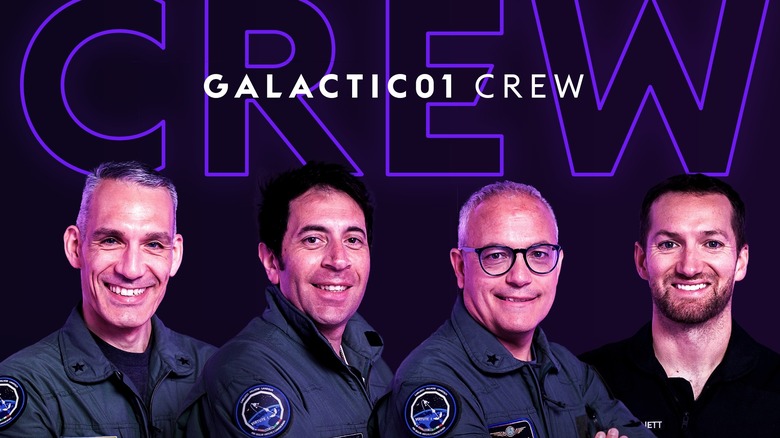Why People Are Worried Virgin Galactic Will Be The Next Titan Sub
Virgin Galactic, a private space tech venture by billionaire Richard Branson, successfully completed its first commercial flight aboard the VSS Unity by taking four passengers to sub-orbital space. The mission was dubbed Galactic 01, and it was a huge milestone for Branson who has been dreaming of commercial space tourism ever since he established Virgin Galactic nearly two decades ago and witnessed multiple setbacks.
Another version of Titan. Ridiculously wealthy ppl choosing to play rather than help the poor. #VirginGalactic
— Iceberg Lady🌏 🇺🇦🌈VOTE YES 🖤💛❤️NO WAR💧 (@muzzlefreemadam) June 29, 2023
But even before the flight could take off — and after it safely returned the crew back to the ground — comparisons were being made between Virgin Galactic and the Titan underwater disaster. Merely a few days before Branson's company could script history, OceanGate's Titan submersible suffered a catastrophic implosion soon after it embarked on a risky underwater tour of the Titanic's wreckage, which ended up with the death of five crew members.
People are drawing parallels between the two events, asking whether Virgin Galactic is on the same trajectory as OceanGate. After all, both companies are selling the promise of an extreme adventure to a clientele that is willing to pay anywhere between a quarter to half a million dollars.
Questions were also raised whether Virgin Galactic could have waited in the wake of the Titan mishap, instead of stirring yet another heated debate about the risks and the real cost of such an extreme brand of tourism. The OceanGate submersible had a patchy record with missions and some glaring engineering concerns. Virgin Galactic isn't unfamiliar with the risks, as it also witnessed a fatal test in 2014.
Virgin Galactic's argument
As the internet compares aspects like risk and liability between Virgin Galactic's milestone achievement and the OceanGate sub disaster, a defense has arrived from the top brass. Virgin Galactic CEO Michael Colglazier sat for an interview with CNBC soon after the company's first commercial mission and made it clear that the two companies and their operations can't be compared in the same vein, labeling it as an "apples to oranges" comparison.
The Virgin Galactic CEO focused on the safety aspect specifically, highlighting the contrast between OceanGate's sub and the safety red flags raised about its operations. "Virgin Galactic ships are built, they're designed, they're maintained in a way that leverages decades of experience in the aerospace industry," Colglazier said.
When we started @VirginGalactic, we had an outlandish dream: to turn commercial space travel into a reality. Virgin Galactic has now completed its inaugural commercial spaceflight. What a moment. https://t.co/eWHfISJjz0 #Galactic01 pic.twitter.com/OEO2G8HQae
— Richard Branson (@richardbranson) June 30, 2023
He also pointed out the critical difference between the regulatory oversight situation for both companies. He mentioned that the company is regulated by the FAA and that it has a valid license for commercial spaceflight operations, adding that the agency "sits with us in mission control at every flight."
Colgalizier didn't directly reference the safety and engineering flaws in the Titan sub pointed out by experts, but he affirmatively addressed the protocols that are in place for its commercial crewed flights. "We do the hard engineering work, we maintain it the right way, and we don't fly until we're ready," said the Virgin Galactic executive.
Regulations and risks
The Titan and Virgin Galactic 01 are two very different kinds of extreme tourism for the ultra-rich, but there's a common thread linking both: risks and regulations. Experts have been calling to regulate both for a while now, but little definitive progress has been made. But there are a few crucial differences between a mission like Titan, and a rocket-fueled jaunt to the edge of space.
SpaceX and Blue Origin are two of the biggest names in the space tourism industry, and they are held to extremely tight safety standards because they also pull double duty as scientific partners for the likes of NASA. SpaceX will be taking a crew to the Moon — and hopefully, Mars, too — aboard its Starship mega-ship, while Blue Origin has bagged contracts to build lunar landers and a private space station.
Welcome back to Earth, #Galactic01! Our pilots, crew and spaceship have landed smoothly at @Spaceport_NM. pic.twitter.com/f8YQowQN2x
— Virgin Galactic (@virgingalactic) June 29, 2023
As such, the independent scrutiny covering safety and reliability is high for their vehicles in NASA contracts. The Titan, on the other hand, wasn't classed. OceanGate only mentioned on its website that it works independently with experts, but even its own customers had raised alarms about the safety track record.
Space tourism doesn't stray too far. In October 2022, NASA drafted rules for private space missions, but they don't cover "edge of space" private rides that Blue Origin and Virgin Galactic offer for hundreds of thousands of dollars. With little regulation and a lack of standardized risk assessment, assuring the safety of such "out of Earth" rides is nigh impossible.
The liability question
Before OceanGate's crew could dive thousands of meters underwater, they reportedly had to sign liability waivers, clearly listing that physical harm — including death — is a possibility. "This operation will be conducted inside an experimental submersible vessel that has not been approved or certified by any regulatory body," said the agreement, further adding that a person who signs it also waives their right to sue the company for injury or loss.
And the situation for private space flights doesn't appear too different. In May, the Senate voted overwhelmingly in favor of a bill that would shield civil space aviation companies like Virgin Galactic and Blue Origin from lawsuits covering the wellness of their private passengers.
Titled the Spaceflight Entity Liability Bill, it exempts space tourism operators from liabilities arising out of injury or death of crew members by making them sign a waiver agreement prior to the flight. The bill doesn't shield companies from "gross negligences," but it's still a glaring peek into the dangers involved with once-in-a-lifetime tourism targeted at the ultra-rich.
Private space tourism rides haven't had a fatal accident so far, but the Titan mishap could very well turn on the regulatory heat on a segment that is growing at an unprecedented pace. Virgin Galactic has reportedly sold over 800 tickets so far after it opened the bookings at $250,000 per seat and then hiked the price to $450,000. So far, Virgin Galactic has only completed one private ride with four passengers.
Who pays for the rescue?
Another crucial question that many are asking on the internet is who ultimately fields the rescue costs of ultra-luxe extreme adventure rides that either go deep into the ocean or high above the Earth's atmosphere if a mishap happens and rescue operations are required. Take for example the unfortunate Titan accident.
As the rescue efforts were underway, the former chief of the US Coast Guard told The Washington Post that the operation would end up costing millions of dollars and that OceanGate won't have to reimburse the US federal government for it. The National Association for Search and Rescue also told The New York Times that the Titan efforts would cost millions of dollars.
At the end of the day, it wasn't OceanGate that had to foot the bill, but it was the US taxpayer's money. In Titan's case, Canada was also involved in the rescue, so there's the cost of multi-national rescue costs to be factored in as well. To recall, OceanGate charged its customers $250,000 per seat, but so far, there is no word whether it also made them sign an insurance clause to foot the search and rescue costs if an accident happens.
At the moment, private space tourism is exempt from safety standardization at the hands of the US Federal Aviation Administration. For what it's worth, the agency told Bloomberg that it is developing a safety framework to regulate human spaceflights. But when it comes to rescue needs, once again, there's no industry-wide consensus.


